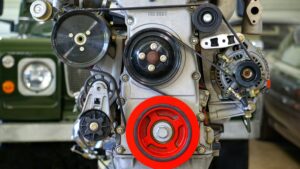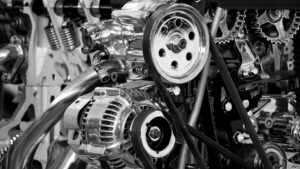CVT Transmission
A Continuously Variable Transmission, or CVT Transmission, is a type of automatic transmission that doesn’t use traditional gears like a manual or automatic transmission. Instead, it operates using a system of pulleys and belts (or sometimes chains) to provide an infinite number of gear ratios within a certain range. This allows for a seamless and smooth acceleration without distinct shifts like in traditional transmissions.

Here are some key points about CVTs:
Infinite Gear Ratios: CVTs don’t have fixed gear ratios like conventional transmissions. Instead, they can continuously adjust the transmission ratio to provide the optimal power and efficiency for a given driving situation. This means the engine can operate at its most efficient RPM (revolutions per minute) for fuel economy or deliver maximum power as needed.
Smooth Operation: CVTs offer a very smooth and uninterrupted acceleration because there are no gear shifts. The transmission smoothly adjusts the ratio as you accelerate, resulting in a consistent and linear feeling of power delivery.
Fuel Efficiency: One of the primary advantages of CVTs is their ability to keep the engine operating in its most fuel-efficient range, leading to improved fuel economy, especially in stop-and-go traffic or during city driving.
Less Maintenance: Since CVTs have fewer moving parts than traditional transmissions, they often require less maintenance. However, they do require specialized maintenance procedures, so it’s essential to follow the manufacturer’s recommendations.
Performance and Driving Experience: Some drivers prefer the traditional feel of gear shifts, and CVTs have faced criticism for not delivering the same driving experience. However, modern CVTs often have simulated “shift points” to mimic the feel of traditional transmissions, and some even offer manual mode or paddle shifters to give the driver more control.
Towing Capacity: CVTs are generally not as well-suited for heavy towing as some other types of transmissions, like automatics with torque converters. If you plan to tow heavy loads regularly, you might want to consider a different transmission type.
Variability: The effectiveness and performance of CVTs can vary among different manufacturers and models. Some CVTs are known for being very efficient and responsive, while others may not provide the same level of performance.
In recent years, CVTs have become more prevalent in various vehicle types, including sedans, hatchbacks, and even some SUVs. They are especially popular in hybrid vehicles, where their efficiency benefits can be maximized.
The primary difference between an automatic transmission and a CVT (Continuously Variable Transmission) lies in how they operate and their internal mechanisms:

Operation:
Automatic Transmission: Traditional automatic transmissions use a complex system of gears, planetary gearsets, and a torque converter to change gears. When you accelerate, an automatic transmission shifts through a set number of discrete gear ratios (e.g., 1st, 2nd, 3rd, etc.).
CVT (Continuously Variable Transmission): CVTs use a system of pulleys and belts (or chains) to provide an infinite number of gear ratios within a certain range. Instead of distinct gears, a CVT continuously adjusts the transmission ratio to provide the optimal power and efficiency for a given driving situation.
Gear Ratios:
Automatic Transmission: Offers a set number of fixed gear ratios. When the transmission shifts, it switches from one gear ratio to another, which can feel like a noticeable “step” in power delivery.
CVT: Provides a seamless and smooth acceleration because it doesn’t have fixed gear ratios. It can continuously vary the transmission ratio to provide a smooth and linear feeling of power delivery.
Fuel Efficiency:
Automatic Transmission: Traditional automatics can be less fuel-efficient than CVTs because they may not always keep the engine in its optimal RPM range for efficiency.
CVT: CVTs are often more fuel-efficient because they can keep the engine operating at its most efficient RPM for a given situation, leading to improved fuel economy.
Driving Experience:
Automatic Transmission: Some drivers prefer the traditional feel of gear shifts and the associated engine noise. Automatic transmissions tend to have more noticeable gear changes.
CVT: CVTs are known for their smooth and uninterrupted acceleration, but some drivers find the lack of traditional gear shifts less engaging. Some modern CVTs have simulated “shift points” to mimic the feel of traditional transmissions, and some offer manual control.
Maintenance:
Automatic Transmission: Automatic transmissions are relatively complex and can require more maintenance over their lifespan.
CVT: CVTs generally have fewer moving parts and may require less maintenance, although they do require specialized maintenance procedures.
Towing Capacity:
Automatic Transmission: Traditional automatic transmissions with torque converters are often better suited for heavy towing due to their ability to handle higher torque loads.
CVT: CVTs may not be as well-suited for heavy towing because they may have limitations in terms of torque handling.
Variability:
The effectiveness and performance of both automatic transmissions and CVTs can vary among different manufacturers and models. Some automatics are more efficient and responsive, while some CVTs may offer a more engaging driving experience.
Automatic vs. CVT: A Comparison
So, you might be wondering, what’s the difference between an automatic and a CVT?
Fuel Efficiency: CVTs tend to be more fuel-efficient because they keep the engine running at its most efficient speed.
Driving Experience: With an automatic, you feel the car shifting gears, which some people like for the excitement. CVTs offer a smoother ride with no gear changes, similar to your bike on a flat road.
Maintenance: CVTs often require less maintenance because they have fewer parts. But don’t forget, they still need specialized care.
Towing Capacity: If you’re planning on towing heavy loads, a traditional automatic might be a better choice. CVT Transmissions might not handle heavy towing as well.
Caring for Your CVT Transmission
Now, let’s talk about how to take care of your CVT-equipped car:
Regular Maintenance: Just like your bike needs regular maintenance, your CVT does too.
Fluid Changes: Changing the CVT fluid is crucial. It’s like replacing the oil in your bike’s chain. The recommended intervals for this can vary, so check your owner’s manual.
Avoid Overheating: Overheating can damage your CVT, so make sure it stays cool. Avoid pushing your car too hard, especially in hot weather or when towing heavy loads.
Consult the Manual: Always consult your vehicle’s manual for specific care instructions. Just as you’d follow your bike’s maintenance guidelines, your car’s manual is your best friend for keeping your CVT in top shape.
The Future of CVT Transmissions:
CVT Transmissions are here to stay, and they have a bright future. As technology advances, CVTs are becoming even more efficient and reliable. You’ll find them not only in regular cars but also in hybrid and electric vehicles. Their ability to keep engines running efficiently makes them a great choice for these eco-friendly cars.
Conclusion:
In summary, CVT transmissions, with their continuous adjustments and smooth rides, have revolutionized the way we drive. They’re a fantastic choice if you prioritize fuel efficiency and a seamless driving experience. Just remember to take care of your CVT by following the maintenance guidelines in your owner’s manual, and it will serve you well for miles to come.
What is Automobile: Click Here
